McCulloch Minimac 14, Minimac 16 User Manual
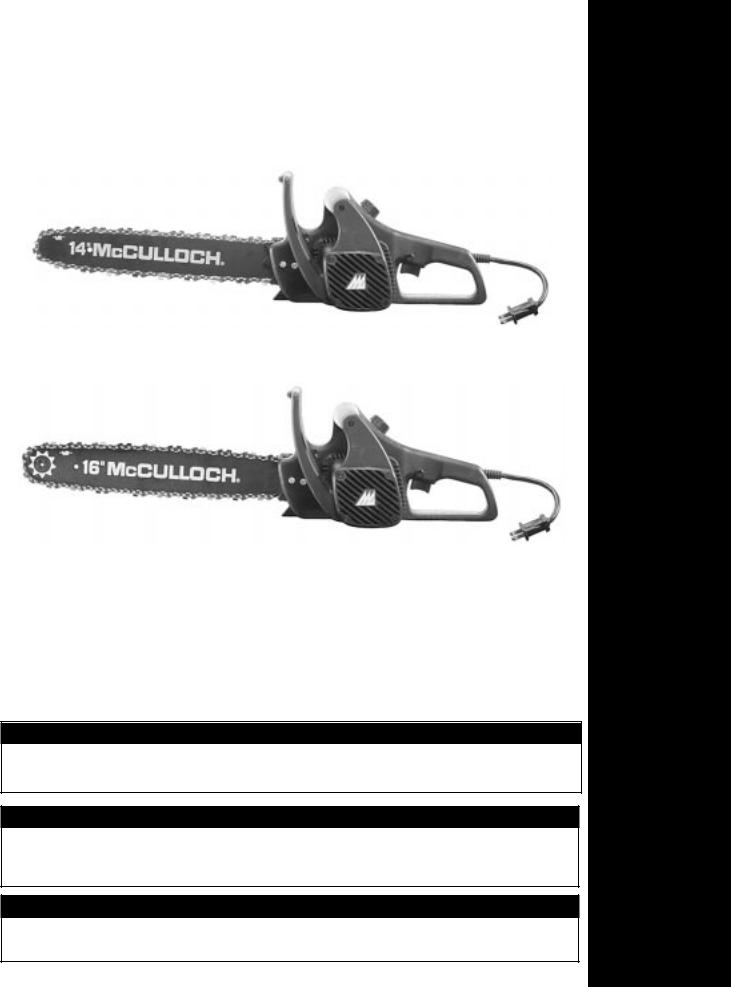
Electric Chain Saws
Tronçonneuses Electriques Sierras Electricas de Cadena
MiniMac 14
MiniMac 16
WARNING • PLEASE READ
Beware of kickback. Hold chain saw firmly with both hands when using. For your own safety, please read and follow the safety precautions in this manual before attempting to operate your chain saw. Improper use can cause serious injury.
SUARIOU ELD ANUELM • UTILISATIOND’ ANUELM
ANUALM SERU
AVERTISSEMENT • LIRE ATTENTIVEMENT
Attention aux rebonds. Tenez toujours la tronçonneuse fermement et des deux mains. Pour votre propre sécurité, veuillez lire attentivement ce manuel et suivre toutes les mesures de précautions indiquées avant de vous servir de la tronçonneuse. Utilisé incorrectment, cet outil peut causer des dommages matériels et/ou coproels graves.
ADVERTENCIA • FAVOR DE LEER
Cuídese de la Reacción. Siempre sostenga la sierra de cadena firmemente con ambas manos cuand la esté usando. Por su propia seguridad, por favor lea y siga las precauciones de seguridad en este manual antes de intentar operar su sierra de cadena. Un uso impropio puede causar lesiones serias.
MODELS
Modèles
Modelos
MiniMac 14
MiniMac 16
PN 212007-00
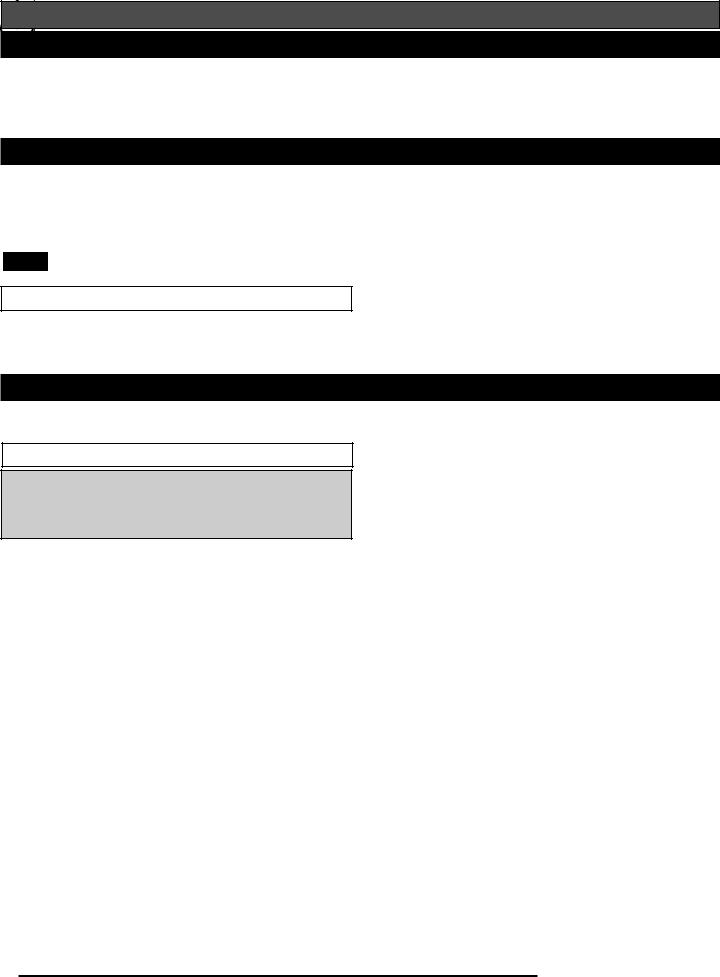
Important! Please read the User Manual.
Table of Contents
Introduction . . . . . . . . . . . . . . . . . . . . . . . . . . . . . . . . . . . . . . . . . . . . . . |
2 |
General Cutting Instructions . . . . . . . . . . . . . . . . . . . . . . . . . . . . . . . . . . |
6 |
Safety Precautions . . . . . . . . . . . . . . . . . . . . . . . . . . . . . . . . . . . . . . . . . |
2 |
Maintenance . . . . . . . . . . . . . . . . . . . . . . . . . . . . . . . . . . . . . . . . . . . . . |
7 |
General Identification . . . . . . . . . . . . . . . . . . . . . . . . . . . . . . . . . . . . . . . |
4 |
Replacement Parts List/Chain Sharpening Tools . . . . . . . . . . . . . . . . . . |
8 |
Assembly Instructions . . . . . . . . . . . . . . . . . . . . . . . . . . . . . . . . . . . . . . |
4 |
Francais . . . . . . . . . . . . . . . . . . . . . . . . . . . . . . . . . . . . . . . . . . . . . . . . . |
9 |
Quick Start . . . . . . . . . . . . . . . . . . . . . . . . . . . . . . . . . . . . . . . . . . . . . . . |
6 |
Español . . . . . . . . . . . . . . . . . . . . . . . . . . . . . . . . . . . . . . . . . . . . . . . . . |
16 |
Introduction
Thank you for purchasing a McCulloch chain saw. With proper operation and maintenance, it will provide you with years of service.
Be certain to familiarize yourself with the contents of the entire User Manual before operating and maintaining your chain saw.
Follow the step-by-step instructions in the manual. You will notice the following call-outs:
NOTE A NOTE is used to convey additional information or highlight a particular explanation.
A Warning or Caution identifies a procedure that, if done improperly, can result in serious personal injury or damage to the chain saw or both.
A Warranty Symbol identifies instructions and/or procedures that must be followed to avoid damage to the chain saw and cancellation of the product warranty. If the warranty is voided, repairs are at the owner’s expense. Damage or conditions which render this product inoperable caused by improper maintenance practices will void the manufacturer’s warranty.
Service, other than user maintenance, should be performed by a McCulloch Authorized Service Center.
Safety Precautions
Safety Precautions for Chain Saw Users
(ANSI B175.1-1991, Annex C) (CAN3-Z62.1 Appendices A, B)
Danger! Beware of Kickback!
Kickback can lead to dangerous loss of control of the chain saw and result in serious or fatal injury to the saw operator or to anyone standing close by. Always be alert! Rotation kickback and pinch kickback are major chain saw operational dangers and the leading causes of most accidents.
BEWARE OF: Rotational Kickback
A = Kickback path
B = Kickback reaction zone
Kickback may occur when the nose or tip of the guide bar touches an object, or when wood closes in and pinches the saw chain in the cut. Tip contact in some cases may cause a lightning fast reverse reaction, kicking the guide bar up and back toward the operator.
A B
A
A
2
BEWARE OF: Pinch Kickback
C = Pull |
D = Solid objects |
E = Push |
Pinching the saw chain along the bottom of the guide bar may pull the saw forward, away from the operator. Pinching the saw chain along the top of the guide bar may push the guide bar rapidly back toward the operator. Any of these reactions may cause you to lose control of the saw, which could result in serious personal injury.
C
D
D
E
GUARD AGAINST KICKBACK: The following precautions should be followed to minimize kickback.
1.GRIP SAW FIRMLY: Hold the chain saw firmly with both hands when the motor is running. Use a firm grip with thumbs and fingers encircling the chain saw handles. The right hand should be on the rear handle, and the left hand on the front handle. Note: If a manual oiler control is provided, additional modified instructions regarding its use are provided.(see chain and bar lubrication)
2.Do not over reach.
3.Keep proper footing and balance at all times.
4.Don’t let the nose of the guide bar contact a log, branch, ground or other obstruction.
5.Do not cut above shoulder height.
6.Use devices, such as low-kickback chain, guide bar nose guards, chain brakes and special guide bars that reduce the risks associated with kickback.
Toll Free Hot Line: 1-800-521-8559

Safety Precautions
7.Only use replacement bars and chains specified by the manufacturer or the equivalent.
NOTE Low-kickback saw chain and bar have met the kickback performance requirements of ANSI B175.1-1991 and is in accordance with CSA Z62.3.
When using an electric chain saw, basic safety precautions should always be read and followed to reduce the risk of fire, electric shock and injury to persons.
Read All Instructions
1.DOUBLE INSULATED - No Serviceable Parts Inside.
2.TO REDUCE THE RISK OF ELECTRICAL SHOCK, this equipment has a polarized plug (one blade is wider then the other) and will require the use of a polarized extension cord. This plug will fit in a polarized extension cord only one way. A polarized extension cord will require the use of a polarized wall outlet. This plug will fit into the polarized wall outlet only one way. If the plug does not fit fully into the wall outlet, reverse the plug. If it still does not fit, contact a qualified electrician to install the proper outlet. Do not change the equipment plug, extension cord receptacle or extension cord plug in any way.
3.POWER SUPPLY: Connect the chain saw to correct voltage; be sure that the voltage supplied is the same as that specified on the nameplate of the tool.
4.KEEP THE WORK AREA CLEAN: Cluttered areas invite injuries. Do not start cutting until you have a clear work area, secure footing, and a planned retreat path from the falling tree.
5.CONSIDER THE WORK AREA ENVIRONMENT: Use extreme caution when cutting small sized brush and sapling, as slender material may catch the saw chain and be whipped toward you or pull you off balance. Do not operate a chain saw in a tree unless you are specifically trained to do so. When cutting a limb that is under tension, be alert for spring back so that you will not be struck when the tension in the wood fibers is released. Do not expose the chain saw to rain.
6.GUARD AGAINST ELECTRIC SHOCK: Prevent body contact with grounded surfaces (i.e., metal pipes, wire fences).
7.KEEP CHILDREN AND BYSTANDERS AWAY: Do not let visitors contact the chain saw or extension cord. All visitors should be kept away from the work area.
8.STORE THE IDLE CHAIN SAW: When not in use, chain saws should be stored out of the reach of children, in a dry, high or locked place. When storing saw, use a scabbard or carrying case.
9.DO NOT FORCE THE CHAIN SAW: The chain saw will do a better and safer job when used at the rate for which it was intended.
10.USE THE RIGHT TOOL: Cut wood only. Do not use the chain saw for purposes for which it was not intended. For example, do not use the chain saw for cutting plastic, masonry or non-building materials.
11.DRESS PROPERLY AND USE SAFETY GEAR: Do not wear loose clothing or jewelry, as they can get caught in moving parts. Non-skid safety footwear is recommended when working outdoors. Wear protective hair covering to contain long hair. Use safety glasses, protective gloves and hearing protection along with safety head gear.
12.CARRYING THE SAW: Carry the saw by the front handle with the saw stopped. Keep your finger off the switch, and make sure that the guide bar and saw chain are to the rear.
13.MAINTAIN THE CHAIN SAW WITH CARE: Inspect the chain saw cord periodically and, if damaged, have it repaired by an authorized service facility. Keep the cord clear of the chain and operator at all times.
Never carry the saw by the cord or pull it to disconnect from receptacle. Keep the cord from oil and sharp edges. Inspect extension cords periodically and replace if damaged. Follow instructions for lubricating and changing accessories. Keep handles dry, clean and free from oil and grease.
14.DISCONNECT THE CHAIN SAW: Disconnect the chain saw when not in use, before servicing and when changing accessories and attachments such as saw chain and guard.
15.OUTDOOR EXTENSION CORDS: Use only extension cords with polarized plugs that are intended for outdoor use.
16.STAY ALERT: Watch what you are doing. Use common sense. Do not operate the chain saw when you are tired. Keep body parts away from the saw chain when the motor is operating. Before you start the saw, make sure the saw chain is not in contact with anything.
17.CHECK DAMAGED PARTS: Before using chain saw, check to determine that it will operate properly and perform its intended function. Check for alignment of moving parts, binding of moving parts, breakage of parts, mounting and any other conditions that may affect its operation. Any damaged part should be properly repaired or replaced by an authorized service center unless otherwise indicated in this instruction manual. DO NOT operate a chain saw that is damaged, improperly adjusted, or not completely and securely assembled. Be sure that the saw chain stops moving when the trigger is released.
18.REPLACEMENT PARTS - When servicing use only identical replacement parts. Bars and chains specified by McCulloch must be used to achieve kickback protection in accordance with CSA Z62.3.
19.DO NOT attempt operations beyond your capacity or experience. Operation of a chain saw should be restricted to mature, properly instructed individuals.
20.DO NOT operate a chain saw with one hand! Serious injury to the operator, helpers or bystanders may result from one-handed operation. A chain saw is intended for two-handed use.
21.TO REDUCE potential for electric shock, do not use chain saw in damp, wet or slippery locations, or during snow storms, rain storms and other adverse weather conditions.
22.DO NOT allow dirt, debris or sawdust to build up on the motor or outside air vents.
23.Follow the manufacturer’s sharpening and maintenance instructions for the saw chain.
24.Cut at high motor speeds.
25.DO NOT FORCE a small saw to do a job requiring a heavier duty unit.
26.EXAMINE THE ELECTRICAL SWITCHES. Do not use the chain saw if the switches do not properly turn on and off. Do not attempt to make any repairs to the electric switches. Take your saw to a McCulloch Authorized Service Center.
27.DO NOT OPERATE YOUR CHAIN SAW near or around flammable liquids or gases, whether in or out of doors. An explosion and/or fire may result.
28.All chain saw service, other than the items listed in the user manual safety and maintenance instructions, should be performed by competent chain saw personnel. Do not attempt to repair it yourself; there are no serviceable parts inside.
29.NEVER REMOVE, modify or make inoperative any safety device furnished with your unit.
30.This electric powered saw is classified by CSA as a Class 2C saw. It is intended for infrequent use by homeowner’s, cottagers and campers, and for such general applications such as clearing, pruning, cutting firewood, etc. It is not intended for prolonged use. If the intended use involves prolonged periods of operation, this may cause circulatory problems in the user’s hands due to vibration. It may be appropriate to use a saw having an anti-vibration feature.
31.WHEN FELLING, keep at least 2 tree lengths between yourself and your fellow workers.
Toll Free Hot Line: 1-800-521-8559 |
|
3 |
|
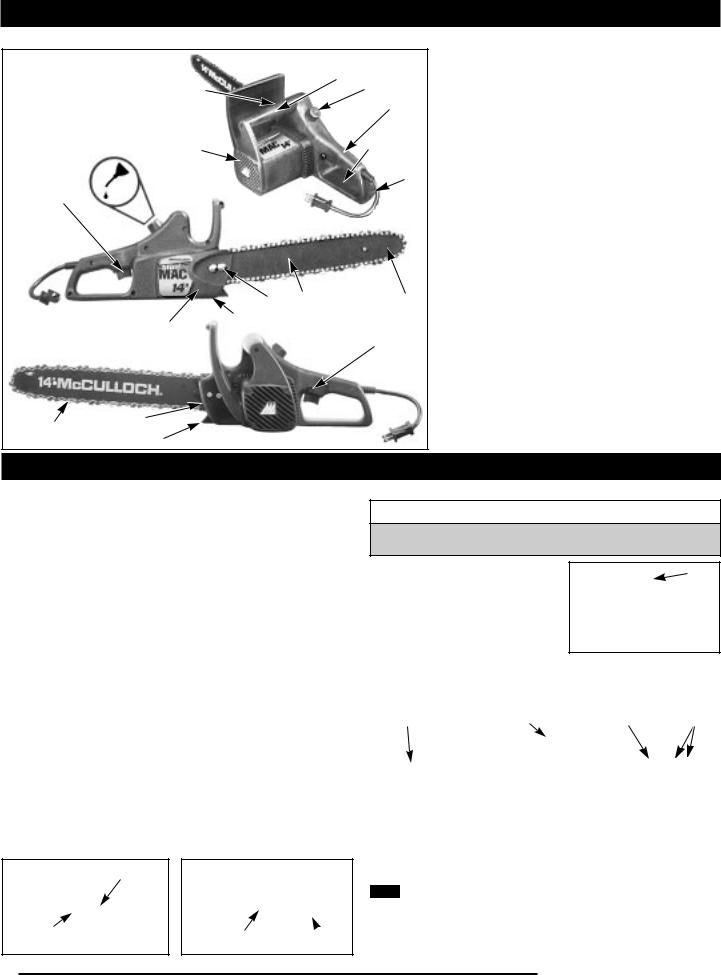
General Identification
General Identification
|
|
|
10 |
|
16 |
|
2 |
|
|
|
|
|
|
|
1 |
|
6 |
|
14 |
|
|
|
|
|
|
|
7 |
3 |
|
|
|
|
5 |
11 |
15 |
4 |
8 |
|
|
|
|
|
|
|
|
|
9 |
13 |
|
|
|
12 |
|
|
|
17 |
|
|
|
|
|
Assembly |
|
Parts Identification
1.Rear Handle
2.Oil Tank Cap
3.Trigger Start/Stop Switch
4.Sprocket Cover
5.Bar Retaining Nuts
6.Electric Motor
7.Electric Cord
8.Chain Catcher
9.Lock/Off Button
10.Front Handle
11.Guide Bar
12.Saw Chain
13.Tension Adjustment Screw
14.Rear Hand Guard
15.Guide Bar Nose
16.Oil Tank Inspection Slot
17.Spikes
Safety Features
3Trigger Start/Stop Switch immediately stops saw motor when released.
6 Electric Motor is double insulated for added safety.
8Chain Catcher reduces the danger of injury in the event saw chain breaks or derails during operation. The catcher is designed to intercept a whipping chain.
9Lock/Off Button prevents accidental acceleration of the saw motor. The trigger cannot be squeezed unless Lock/Off button is depressed.
12Low-Kickback Bar and Chain helps significantly reduce kickback, or the intensity of kickback, due to specially designed depth gauges and guard links.
Introduction
This unit is designed for occasional homeowner use and should not be used for commercial purposes or subjected to heavy continuous use.
Your new chain saw can be used for a variety of projects such as cutting firewood, making fence posts, felling small trees, limbing, pruning at ground level, and light carpentry. Cut only wood or wood products with your saw.
Tools for Assembly
Your User’s Kit may contain a combination wrench/screwdriver (scrench) and is the only tool you will need to assemble your unit and to adjust the saw chain tension.
Assembly Requirements
Your new chain saw will require installation of the guide bar, saw chain, sprocket cover, adjustment of chain, and filling the oil tank with lubricating oil, before the unit is ready for operation. Do not start the saw motor until the unit is properly assembled. Read all instructions carefully. Do not install any other size bar and chain than what is recommended for your model.
Guide Bar/Saw Chain Installation
To Install Guide Bar
1.Place power unit on flat surface and remove bar bolt nuts and sprocket cover.
2.Using a straight screwdriver or the scrench, if provided in your User’s Kit, turn the chain adjustment screw (A) counterclockwise as far left as it will go, or until the Tang (B) (projecting prong) is to the end of its travel.
3.Place the slotted end of the guide bar over the bar bolts so the Tang
(B)fits into the lower hole (C) in the guide bar (D).
A
B C  D
D
4
To Install Saw Chain
Whenever handling the saw chain, wear work gloves for protection against sharp cutting edges.
1. Spread the chain out with the cutting |
E |
edges (E) of the chain pointing in the |
|
DIRECTION OF ROTATION. |
|
2.Place the chain over the sprocket (F) with drive links fitting between sprocket teeth. Guide the chain links into the groove (G) on the top side of the guide bar and around the nose. The
saw chain will droop slightly on the lower part of the guide bar.
3.Install the sprocket cover (H). Place the cover over the 2 bar bolts. Thread the retaining nuts (J) FINGER TIGHT ONLY.
F |
G |
|
H |
J |
|
|
|
|
|
SAW CHAIN TENSION ADJUSTMENT
Proper tension of the saw chain is extremely important and must be checked before starting any cutting operation. Taking the time to make needed adjustments to the saw chain will result in improved cutting performance and prolonged chain life.
NOTE A new chain and bar will need readjustment after as few as 5 cuts. This is normal during the break-in period, and the interval between future adjustments will lengthen quickly.
Toll Free Hot Line: 1-800-521-8559
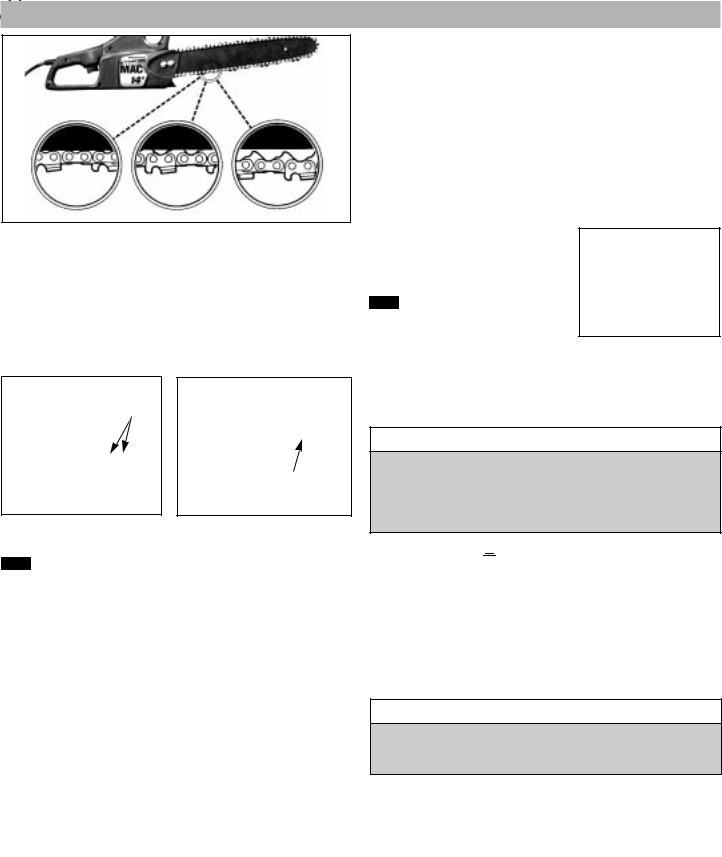
Assembly
A B C
Chain Tensions
CAUTION: If a chain is TOO LOOSE or TOO TIGHT, the bar, chain and saw bearings will wear more rapidly. Study the figure above for information concerning correct cold tension (A), correct warm tension (B), and as a guide for when saw chain needs adjustment (C).
To Adjust Saw Chain Tension:
1.Loosen the bar retaining nuts (J) so they are hand tight.
2.Holding the nose of the bar up, use the screwdriver or scrench if provided in your User’s Kit to turn the guide bar adjustment screw (F) clockwise to tighten the chain. Turning the screw COUNTERCLOCKWISE LOOSENS THE CHAIN on the guide bar.
J
F
3.After adjustment and while wearing heavy duty work gloves, move the saw chain back and forth on the guide bar to be sure the chain moves freely and is in proper mesh with sprocket.
NOTE If the chain is difficult to rotate or if it binds on the guide bar, too much tension has been applied and must be adjusted. To decrease tension, turn the adjustment screw counterclockwise slowly. Move the chain back and forth until it moves freely.
4.Holding the nose in upper position, securely tighten the bar retaining nuts (70 inch lbs.).
Filling Oil Tank
Using a funnel, fill oil tank with McCulloch Chain, Bar and Sprocket oil. Wipe up any spills. Make sure no dirt gets into the oil tank.
The saw chain requires lubrication while in use to minimize friction with the guide bar. The oil tank holds enough to lubricate the chain for 12-15 minutes of sawing.
We recommend using McCulloch Chain, Bar and Sprocket Oil, which contains additives to reduce friction wear and reduce resin residue formations.
If McCulloch Chain, Bar and Sprocket Oil is not available, use SAE 30 nonadditive motor oil above 40˚F (5˚C) and SAE 10 non-additive motor oil at lower temperatures.
CAUTION: The oil tank level should be frequently checked during operation to avoid starving the bar and chain of lubrication. The oil tank level can be checked in the inspection slot provided on the left side of the saw. (see chain and bar lubrication)
CAUTION: Never starve the bar and chain of oil. Running the saw DRY or with TOO LITTLE OIL will decrease cutting efficiency, shorten saw chain life and cause rapid dulling of the chain and overheating which dulls the chain and wears the bar. When this occurs, smoke or bar discoloration can be seen.
Extension Cords
1.When using the appliance, an extension cord with a polarized plug and polarized outlet must be used
2.The extension cord must be of adequate size for safety and to prevent loss of power and overheating. It must be specifically intended for outdoor use and be marked SW-A, SOW-A, STOW-A, SJW-A, SJOW-A SJTOW-A, SJTW-A, OR SJTW. Follow cord size requirements below:
Cord Length |
AWG Cord Size |
|
|
|
|
25 |
Feet |
16 |
50 |
Feet |
16 |
100 |
Feet |
14 |
150 |
Feet |
12 |
|
|
|
3.When using an electric chain saw, plug it into the extension cord only when you are ready to cut wood. Connect the extension cord to a 110/120 voltage outlet.
NOTE To prevent disconnection of the extension cord, tie a loose knot before connecting the ends together.
 CAUTION: A cord that is hot to the touch is overloaded.
CAUTION: A cord that is hot to the touch is overloaded.
4.When using the appliance, an extension cord of adequate size must be used for safety and to prevent loss of power and overheating.
5.Inspect the extension power cord for loose or exposed wires and damaged insulation. If damaged, replace before using the appliance.
Do not operate your chain saw in a wet or damp environment. Do not expose the saw to rain, snow or sleet. Moisture will cause short circuits. Replace or repair any damaged or frayed extension cords before using your saw.
Keep the cord away from the cutting area and position the cord so that it will not be caught on branches or other objects during cutting.
Double Insulation 
No Serviceable Parts Inside
Do not use if the cord or plug is damaged. Your appliance is double insulated to help protect against electric shock. Double insulation construction consists of 2 separate “layers” of electrical insulation.
Appliances built with this insulation system are not intended to be grounded. As a result, the extension cord used with your appliance can be plugged into any conventional 120 volt electrical outlet.
Normal safety precautions must be observed when operating an electrical appliance. The double insulation system is only for added protection against injury resulting from a possible internal electrical insulation failure.
Your double insulated appliance has no serviceable parts inside. Do not attempt to repair it yourself. For service information, contact the McCulloch Product Service Department toll-free number listed on the back cover of this manual.
Toll Free Hot Line: 1-800-521-8559 |
|
5 |
|
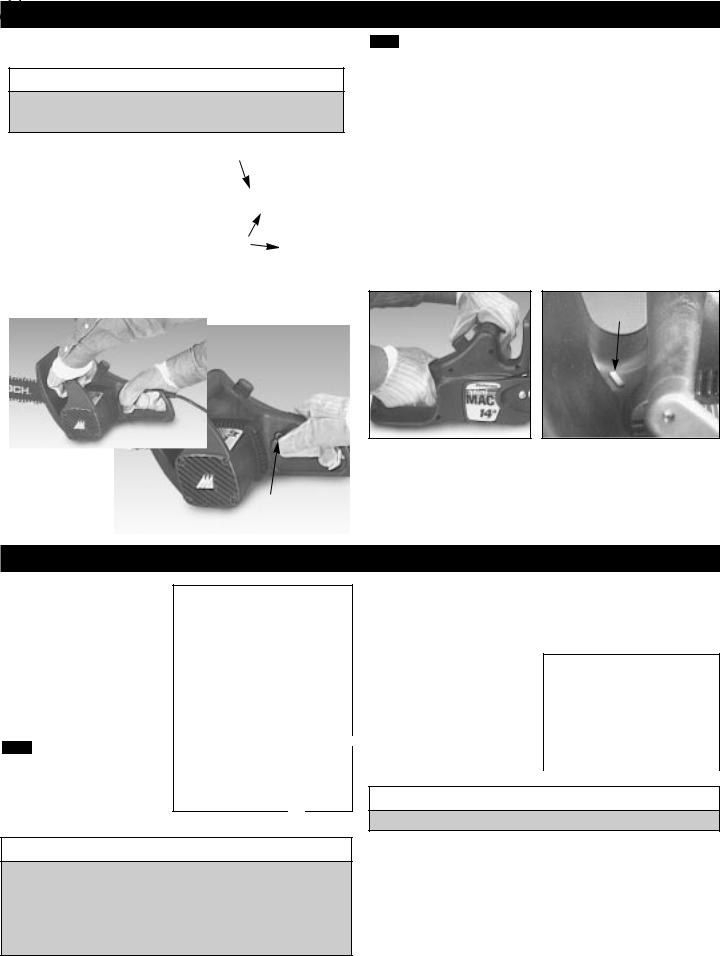
Quick Start
1.PLEASE READ ALL WARNINGS.
2.Make sure oil reservoir is full.
Ensure the extension cord is of the proper size and type for your saw. Make sure the extension cord does not come in contact with the guide bar and saw chain.
To Start Saw |
A |
3. Plug the cord (A) into the appropriate |
|
size extension cord (B). Plug the |
|
extension cord into a 110/120 volt AC, |
|
15 AMP receptacle. |
|
4. Grip the saw with both hands, left |
|
hand holding the front handle and the |
B |
right hand holding the rear handle. |
|
Thumbs and fingers should encircle |
|
both handles as shown below left. |
|
5.With your right thumb, depress the LOCK/OFF button (C) on the side of the rear handle. At the same time, squeeze the trigger. To stop the saw, release the trigger.
NOTE It is not necessary to maintain pressure on the LOCK/OFF button once the trigger is squeezed and the motor is running. The LOCK/OFF button will have to be depressed and the trigger squeezed to restart the motor.
To Stop Motor
The saw motor will automatically stop when the trigger is released. The LOCK/OFF button will have to be depressed and the trigger squeezed to restart the motor.
Chain and Bar Lubrication
Adequate lubrication of the saw chain during cutting operations is essential to minimize friction with the guide bar. Your chain saw is equipped with a manual oiler. Priming can increase the flow of oil to the bar. To prime the chain saw press on the oil cap as shown below. Do not prime the oiler while chain saw is running. Tilt the chain saw bar down slightly while pressing the manual oiler for the best results. The oil tank level can be checked in the inspection slot (D) provided on the left side of the saw. Tank is full when oil is at top of the slot. Always use a funnel when filling the oil tank. Thoroughly clean all excess oil off the chain saw housing and hand grips before operating.
D
|
|
|
CAUTION: Never starve the bar and chain of oil. Running the saw |
|
|
|
|
|
|
|
|
|
|
|
DRY or with TOO LITTLE OIL will decrease cutting efficiency, shorten |
|
|
|
saw chain life and cause rapid dulling of the chain and overheating |
|
|
|
which dulls the chain and wears the bar. When this occurs, smoke or |
|
|
C |
bar discoloration can be seen. |
|
|
|
|
|
|
|
|
Cutting Instructions
Felling a Tree
Felling is the term for cutting down a tree. Small trees up to 6-7'' (1518cm) in diameter are usually cut in a single cut. Larger trees require notch cuts. Notch cuts determine
the direction the tree will fall.
B
CAUTION: If felling a tree on sloping ground, the chain saw operator should keep on the uphill side of the terrain, as the tree is likely to roll or slide downhill after it is felled.
NOTE Direction of fall (B) is controlled by the notching cut. Before any cuts are made,
consider the location of larg- A er branches and natural lean
of the tree to determine the way the tree will fall.
A retreat path (A) should be planned and cleared as necessary before cuts are started. The retreat path should extend back and diagonally to the rear of the expected line of fall, as illustrated above.
Do not cut down a tree during high or changing winds or if there is a dan-ger to property. Consult a tree professional.
Do not cut down a tree if there is a danger of striking utility wires; notify the utility company before making any cuts.
General Guidelines for Felling a Tree:
Normally felling consists of 2 main cutting operations, notching (C) and making the felling cut (D).
Start making the upper notch cut (C) on the side of the tree facing the felling direction (E). Be sure you don’t make the lower cut too deep into the trunk.
The notch (C) should be deep |
|
|
|
|
|
enough to create a hinge (F) of suffi- |
|
|
|
|
|
cient width and strength. The notch |
|
|
|
E |
|
1.5-2'' |
3/4 |
1/4 |
|||
should be wide enough to direct the |
|
||||
|
|
|
|||
fall of the tree for as long as possi- |
3-5cm |
|
|
|
|
ble. |
|
|
|
C |
|
Make the felling cut (D) from the |
|
|
|
|
|
other side of the tree and 1.5'' - 2.0'' |
|
|
|
F |
|
(3-5cm) above the edge of the notch |
|
D |
|
|
|
(C) as shown to the right. |
|
|
|
||
|
|
|
|
Never walk in front of a tree that has been notched.
Never saw completely through the trunk. Always leave a hinge. The hinge guides the tree. If the trunk is completely cut through, control over the felling direction is lost.
Insert a wedge or felling lever in the cut well before the tree becomes unstable and starts to move. This will prevent the guide bar from binding in the felling cut if you have misjudged the falling direction. Make sure no bystanders have entered the range of the falling tree before you push it over.
6 |
|
Toll Free Hot Line: 1-800-521-8559 |
|
Felling Cut:
Toll Free Hot Line: 1-800-521-8559 |
|
7 |
|
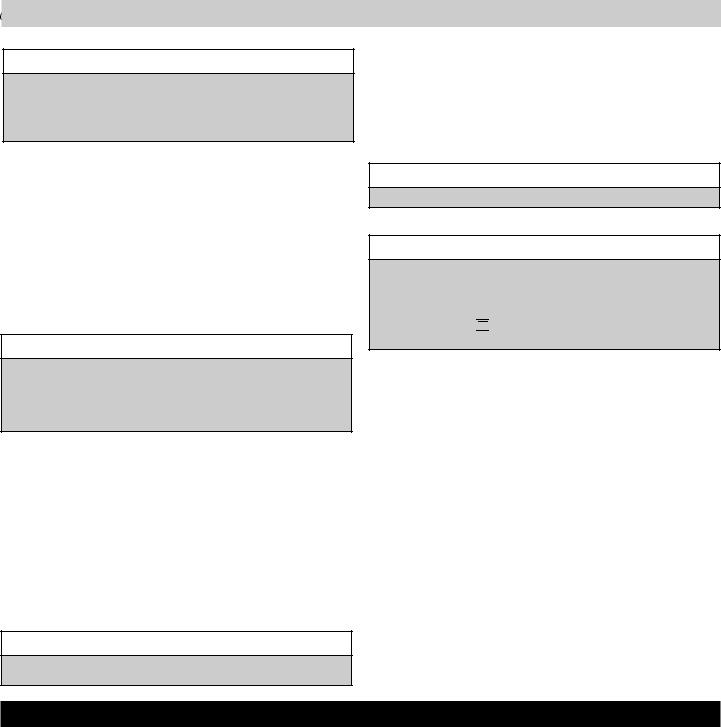
Maintenance
Chain Maintenance
Unless you have experience and specialized training for dealing with kickback (see Safety Precautions), always use a low-kickback saw chain, which significantly reduces the danger of kickback. Low-kickback saw chain does not completely eliminate kickback. A low-kickback or “safety chain”, should never be regarded as total protection against injury.
A low-kickback saw chain should always be used. Always use a replacement saw chain designed as “low-kickback” or a saw chain which meets the low-kickback performance requirements of ANSI (American National Standards Institute).
A standard saw chain (a chain which does not have the kickback reducing guard links) should only be used by an experienced professional chain saw operator.
What is a Low-Kickback Saw Chain?
A low-kickback saw chain is a chain which has met the kickback performance requirements of ANSI B175.1.
By keeping the saw chain in good working condition and correctly serviced as recommended in this manual, you will be able to maintain the safety system of your chain saw over the life of the product.
Never remove, modify or make inoperative any safety device furnished with your unit. The low-kickback saw chain and bar are major safety features provided for your protection.
Always wear heavy duty protection work gloves and disconnect the extension cord when working on the saw chain.
Chain Tension:
Check the chain tension frequently and adjust as often as necessary to keep the chain snug on the bar, but loose enough to be pulled around by hand. (See Assembly)
Breaking in a New Chain Saw
A new chain and bar will need readjustment after as few as 5 cuts. This is normal during the break-in period, and the interval between future adjustments will begin to lengthen quickly.
Over a period of time, however, the moving parts of the saw chain will become worn, resulting in what is called CHAIN STRETCH. This is normal. When it is no longer possible to obtain correct chain tension adjustment, a link will have to be removed to shorten the chain. See your McCulloch Authorized Service Center, listed under “SAWS” in your Telephone Directory Yellow Pages, to have this repair performed.
Chain Lubrication:
Adequate lubrication of the saw chain during cutting operations is essential to minimize friction with the guide bar. Your chain saw is equipped with a manual oiler. The oil tank level can be checked in the inspection slot provided on the left side of the saw. (see chain and bar Lubrication)
CAUTION: Never starve the bar and chain of oil. Running the saw DRY or with TOO LITTLE OIL will decrease cutting efficiency, shorten
saw chain life and cause rapid dulling of the chain and overheating which dulls the chain and wears the bar. When this occurs, smoke or bar discoloration can be seen.
Never cut tree limbs while standing on tree trunk.
Preventative Maintenance
In this double insulated appliance, 2 systems of insulation, instead of grounding, are provided. No grounding means is provided on a double insulated appliance, nor should a means for grounding be added to the appliance. No serviceable parts are inside. A double insulated appliance is marked with the words, “DOUBLE INSULATION” or “DOUBLE INSULATED.” The symbol  (square within a square) may also be marked on the appliance.
(square within a square) may also be marked on the appliance.
Servicing a Double Insulated Appliance 
1.Place switch in OFF position and unplug the power supply before the appliance is serviced, cleaned, or maintenance is performed.
2.Keep the air intake clean and air vents free of debris to avoid overheating the motor.
3.Clean with a damp sponge and mild soap. Do not squirt with a water hose or douse with water or other liquids.
4.Inspect the saw chain for proper tension before each use and frequently during cutting. Sharpen as required.
5.Clean the guide bar and bar pad to ensure free path for oil.
6.Turn the bar over after each use to achieve even wear.
7.No motor lubrication is necessary. The motor is equipped with lifetime lubricated bearings.
8.If the saw does not operate, turn switch OFF position and disconnect the extension cord, first from the power supply, then from the saw. Check the power supply for blown fuses or tripped circuit breakers. If it still does not operate, contact the McCulloch Product Service Department, through the toll-free number listed on the back cover of this manual, for service information. Do not attempt to repair it yourself. No serviceable parts are inside.
Never have more than 3 links removed from a loop of chain. This could cause damage to the sprocket.
Replacement Parts
Chain Saw Replacement Parts
MODEL |
Mini-Mac 14 |
Mini-Mac 16 |
Bar |
325468 |
325492 |
|
14” Low-kickback Bar |
16” Low-kickback Bar |
Chain |
214919 |
214925 |
|
49 Drive Links |
54 Drive Links |
|
Low-kickback Chain |
Low-kickback Chain |
|
|
|
Bar Retaining Nut |
22279 |
22279 |
|
HX 1/4-28 Flng |
HX 1/4-28 Flng |
|
|
|
Bar Adjusting Nut |
40900 |
40900 |
|
|
|
Bar Adjusting Screw |
223088 |
223088 |
|
|
|
Oil Cap |
325470 |
325470 |
|
|
|
Retaining Ring |
110907 |
110907 |
|
|
|
File and Guide |
301992 |
301992 |
|
|
|
File |
214217 |
214217 |
|
|
|
For performance and safety reasons, use only McCulloch accessories and replacement parts. There are no other replacement components for achieving kickback protection in accordance with CSA Z62.3.
8 |
|
Toll Free Hot Line: 1-800-521-8559 |
|
